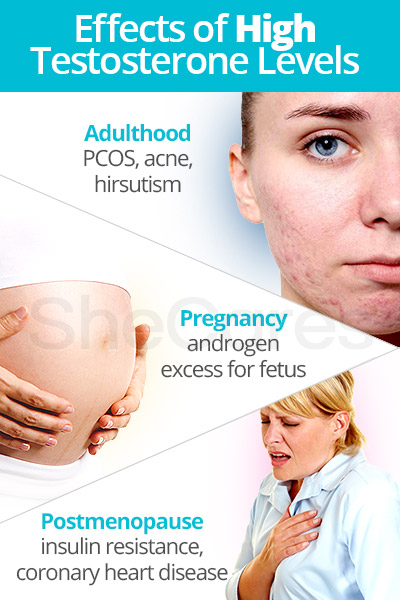Healthy testosterone levels in women contribute to the functioning of the reproductive and endocrine glands, brain, heart, and more.
Continue to the following section to discover more about normal testosterone levels and their importance, including any unwanted effects evoked by an imbalance throughout various life stages.
Ranges of Normal Testosterone Levels
The following table shows the reference ranges of total testosterone levels for a woman at varying times during and after her reproductive years. Measurements are taken from blood plasma and provided in ng/dL (nanograms/deciliter).
- Puberty
- Adulthood
- Pregnancy
- Postmenopause
6 - 86
26 - 309
2 - 41
The total testosterone level reflects the amount of hormones that attach to proteins in the blood (albumin and sex hormone binding globulin, or SHBG) as well as testosterone that is not attached to proteins.
Free testosterone is the term for testosterone hormones that are not attached to the proteins. The free testosterone range should be around 2.5 percent of a woman's total testosterone.
Additionally, bioavailable testosterone is the collective term for free testosterone and albumin-bound testosterone. This type of testosterone is easily used in the body and acts on target tissues.
If a doctor believes a woman has high or low testosterone, her levels of total testosterone will be tested first. Keep in mind that measured levels can vary depending on the type of test taken and that testosterone reference ranges will differ between labs.
During adulthood

Women in their reproductive years will have the highest testosterone levels up until their 30s. Its levels are believed to be most elevated in the morning with levels fluctuating throughout the day.
During pregnancy
Maternal serum testosterone concentrations can increase by 70 percent or more during pregnancy. Also, younger maternal age is associated with higher testosterone levels in pregnancy. Levels will steadily increase throughout gestation and should return to normal soon after parturition.
During postmenopause
After the menopause date, daily total testosterone levels are generally between 2 and 41 ng/dL. Unlike estrogen and progesterone, testosterone is continually produced by the adrenal glands and ovaries during this time. The hormone can also be converted to estrogens by action of enzymes in certain peripheral tissues in postmenopausal women.
Importance of Normal Testosterone Levels
As introduced, the reproductive system is not the only bodily system in which effects of healthy testosterone levels are felt. The following examples are just a select few of how the hormone influences general well-being.
During adulthood
- Improves mood and sex drive
- Promotes overall health of the reproductive tract
- Stimulates production of red blood cells, thus deterring anemia
Before/ During pregnancy
- Stimulates ovulation
- Increases fertility
- Helps with nausea symptoms during early pregnancy
During postmenopause
- Encourages bone growth and density
- Upholds greater skin collagen content
- Improves memory, thus helping prevent onset of Alzheimer's
Many of the above-mentioned effects occur throughout life no matter a woman's reproductive stage.
Read more about testosterone's role and effects for an amplified understanding of exactly how much the hormone affects a woman's body.
What Happens When Testosterone Levels are High?
As with other reproductive hormones, current testosterone levels are dependent upon many factors, including a woman's age.
Nevertheless, testosterone levels that are out of balance can induce numerous unwanted side effects.
During adulthood

Excess testosterone levels in women can cause a condition known as polycystic ovarian syndrome (PCOS), which is characterized by hirsutism, acne, male patterned baldness, deepening voice, and increased muscle bulk. This condition usually starts in adolescence and gradually progresses throughout reproductive years with severity depending upon various factors.
During pregnancy
Abnormally high testosterone levels during a pregnancy, especially for women with PCOS, leads to an increase in androgen concentrations in utero. These could result in androgen excess for the fetus. Further studies are needed to evaluate its long-term effect on baby girls born to PCOS mothers, especially if they grow up to have PCOS or insulin resistance.
During postmenopause
PCOS in postmenopausal women is not well-defined, and it is believed that elevated androgen levels will continue into early postmenopause.
Moreover, research studies have shown that higher testosterone levels in women are associated with insulin resistance, metabolic syndrome, and coronary heart disease in older women. There is controversy as to whether the imbalance predisposes postmenopausal women to other hormone-dependent conditions as well.
Read more information about high testosterone levels, including its varying signs and symptoms.
What Happens When Testosterone Levels are Low?
During adulthood

Low androgen and testosterone levels may lead to a variety of symptoms normally associated with the menopausal transition, such as physical fatigue, lack of well-being, breast pain, hot flashes, dysphoric mood (anxiety, irritability, depression), and more.
During pregnancy
Unlike estrogen and progesterone, firm data has yet to be released on how low testosterone levels during pregnancy affect the mother-to-be and baby.
Nevertheless, some women are known to experience symptoms associated with low levels of testosterone, such as low libido, during early motherhood.
During postmenopause
Testosterone levels that fall below normal for an extended period of time after menopause may also cause muscle loss, changes in cognition, incontinence, sexual dysfunction, and joint pain, among other symptoms. Additionally, low testosterone levels may be associated with bone loss and an increased risk for heart disease.
To clear up any questions concerning testosterone balance and how it affects women's health, continue on to discover more about low testosterone levels and its origins.
Sources
- American Association for Clinical Chemistry. (2016). Testosterone. Retrieved July 16, 2018, from https://labtestsonline.org/tests/testosterone
- Glaser, R. & Dimitrakakis, C. (2013). Testosterone therapy in women: Myths and misconceptions. Maturitas, 74(3), 230-234. doi: 10.1016/j.maturitas.2013.01.003
- Immuno Biological Laboratories. (n.d.). Hormone Therapy: Hormone References. Retrieved July 16, 2018, from http://www.hemingways.org/GIDinfo/hrt_ref.htm
- Markopoulos, M.C. et al. (2015). Hyperandrogenism after menopause. European Journal of Endocrinology, 172, R79-R91. doi: 10.1530/EJE-14-0468
- Patel, S.M. et al. (2009). Higher Serum Testosterone Concentration in Older Women is Associated with Insulin Resistance, Metabolic Syndrome, and Cardiovascular Disease. The Journal of Clinical Endocrinology & Metabolism, 94(12), 4776-4784. doi: 10.1210/jc.2009-0740
- Sir-Petermann, T. et al. (2002). Maternal serum androgens in pregnant women with polycystic ovarian syndrome: possible implications in prenatal androgenization. Human Reproduction, 17(10), 2573-2579. doi: 10.1093/humrep/17.10.2573
- University of Iowa Health Care. (2016). Testosterone, Free and Total, Adult. Retrieved July 16, 2018, from https://www.healthcare.uiowa.edu/path_handbook/handbook/test1802.html
- University of Rochester Medical Center. (n.d.). Total Testosterone. Retrieved July 16, 2018, from https://www.urmc.rochester.edu/encyclopedia/content.aspx?contenttypeid=167&contentid=testosterone_total



